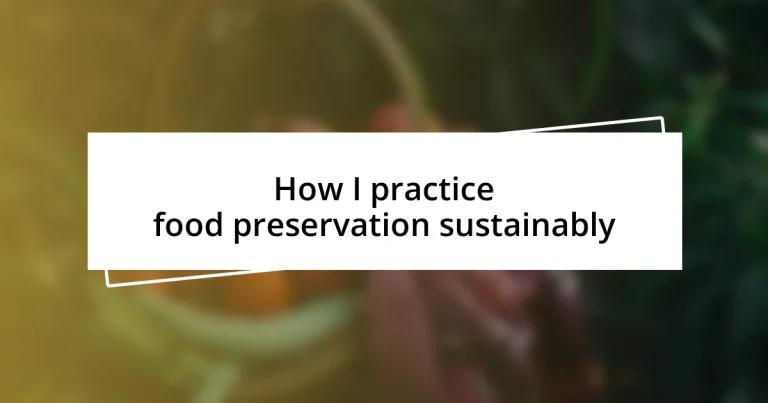Key takeaways:
- Food preservation methods like canning, freezing, fermentation, and dehydration help retain nutrients and enable year-round enjoyment of seasonal produce.
- Choosing sustainable ingredients, such as locally sourced and organic products, supports the environment and local communities while enhancing flavor.
- Effective food storage practices and creative repurposing of leftovers minimize waste and promote efficiency in the kitchen, ultimately benefiting both health and sustainability.

Understanding food preservation methods
Food preservation methods are fascinating, aren’t they? I remember my grandmother’s pantry filled with beautifully labeled jars of fruits and vegetables. Each jar held a story, a season perfectly captured and stored for future enjoyment. This nostalgic experience is part of what fuels my interest in sustainable food preservation today.
Preservation techniques like canning, freezing, and dehydrating serve different purposes depending on the food and desired outcome. For instance, when I first tried drying herbs from my garden, I was amazed at how simple it was. The rich aroma that filled my kitchen as they dried was invigorating. It got me thinking—what if more people knew about these sustainable methods?
Understanding the science behind food preservation is crucial for making informed choices. I often ask myself, which method retains the most nutrients? If I want my family to enjoy healthy meals year-round, choosing the right preservation technique becomes essential. Have you ever wondered how your favorite summer fruit can still taste bright in the depths of winter? That’s the magic of food preservation.

Choosing sustainable ingredients
Choosing sustainable ingredients is a journey I’ve cherished. My trips to the local farmers’ market always inspire me; the vibrant colors and inviting aromas pull me in. When I buy seasonal produce, I feel a connection to the earth and the community, knowing that I’m supporting local farmers and reducing my carbon footprint. It’s incredibly satisfying to know that my choices can create a ripple effect for sustainability.
Thinking about sustainability extends beyond just the source of the ingredients; it also encompasses their methods of cultivation. I often ponder the importance of organic versus conventional farming. When I selected a batch of heirloom tomatoes last summer, the vendor explained how these varieties promote biodiversity. Those tomatoes tasted so much richer, and I could tell they were grown with care. It’s moments like these that reinforce my belief in choosing ingredients that nourish not just my family but the planet, too.
I challenge myself to be mindful of every ingredient I use. Whether it’s diving into the specifics of food miles or investigating packaging waste, each aspect adds up. For example, I’ve recently shifted towards purchasing grains from bulk bins. Not only does this reduce packaging, but it also allows me to explore new varieties that I otherwise wouldn’t have tried. Isn’t it fascinating how exploring sustainable choices can lead to delightful culinary adventures?
| Sustainable Ingredient Types | Benefits |
|---|---|
| Locally Sourced Produce | Supports local economies, reduces transport emissions |
| Organic Grains | Healthier farming practices, improves soil health |
| Heirloom Varieties | Promotes biodiversity, often richer in flavor |
| Seasonal Ingredients | Maximal freshness, minimal environmental impact |

Techniques for water-saving preservation
When it comes to conserving water while preserving food, my go-to methods are fermentation and dehydration. I remember the excitement of my first batch of fermented pickles; the bubbling jars sat on my countertop, transforming fresh cucumbers into tangy goodness without any water waste. It’s fascinating how fermentation utilizes the natural moisture in the ingredients themselves, essentially becoming a vibrant ecosystem in a jar. Dehydrating, too, is a truly efficient method. I can dry trays of fruits and veggies with just a fraction of the water used in traditional canning, which really resonates with my goal of sustainable living.
Here are some key techniques that effectively save water during food preservation:
- Fermentation: This method uses the natural moisture in foods to create delicious results, encouraging beneficial bacteria to thrive while conserving water.
- Dehydration: Removing water from fruits and vegetables concentrates flavors without needing water for preservation, making it a great choice for sustainability.
- Solar Drying: Harnessing sunlight for drying can be a fun, resourceful way to reduce energy and water use, especially in warm climates.
- Freezing: Although freezing requires water, by blanching vegetables in a limited amount of water, you preserve nutrients and flavor without excess waste.
- Pressure Canning: This technique uses less water than water-bath canning and effectively creates a vacuum seal that locks in food’s freshness.
Each method offers a unique opportunity to be resourceful while minimizing water usage, which is something I hold dear in my preservation journey.

Utilizing energy-efficient appliances
Utilizing energy-efficient appliances in food preservation has been a game-changer in my kitchen. Transitioning to a high-efficiency refrigerator not only keeps my ingredients fresh but also lowers my energy bills, which feels like a win-win to me. I remember a time when I was using an older model that consumed way too much energy, and switching to an ENERGY STAR-rated appliance significantly decreased my environmental impact—who knew a fridge could make such a difference?
Slow cookers and pressure cookers are my saving grace for energy-efficient preservation. One evening, I tossed in a mix of leftover veggies and spices into my slow cooker, and by morning, I had a hearty soup that took minimal energy to prepare. It’s amazing how these appliances can create delightful meals with less energy than traditional methods. Plus, they gently cook food, preserving nutrients that might otherwise be lost—saving energy and maximizing flavor, what’s not to love?
I also find joy in utilizing my dehydrator. I often prepare batches of herbs and fruits, making the most of what I can grow or buy in bulk. Not only does it use less energy compared to conventional drying methods, but I enjoy the simple pleasure of watching my produce transform. Have you ever experienced that moment of satisfaction when you finally taste the fruits of your labor? It reinforces my belief that small, energy-conscious choices lead to a bigger impact—both for the planet and for my pantry.

Tips for safe food storage
When it comes to safe food storage, one of the first things I always emphasize is temperature control. Keeping your refrigerator at the right temperature— ideally around 35°F to 38°F—can significantly slow down bacterial growth. I learned this the hard way after losing a batch of homemade salsa that sat at a higher temperature for too long. It’s just heartbreaking to waste something you’ve put so much effort into!
Another crucial tip is using airtight containers. I swear by glass jars and reusable silicone bags. Not only do they keep food fresher for longer, but they also help reduce plastic waste. I remember feeling a sense of relief when I switched to these containers; eliminating single-use plastics from my kitchen uplifted my spirit, making me feel like I’m contributing positively to the environment. Plus, there’s just something gratifying about seeing all those beautifully labeled jars stocked up in the fridge!
Lastly, always label your food with the date you stored it. It sounds simple, but this practice really helps keep track of freshness— a lesson I learned during a pantry clean-out where I discovered some not-so-fresh leftovers lurking in the back. Now, I feel so much more organized, and it eliminates the guesswork when meal prepping. What can I say? It’s those little practices that keep my food safe and my kitchen thriving.

Creative ways to repurpose leftovers
Finding creative ways to repurpose leftovers has truly transformed my approach to cooking. One of my favorite tricks is turning last night’s roasted vegetables into a delicious frittata. I’ll whisk up some eggs and throw in the leftover veggies, and in no time, I’ve got a wholesome breakfast that feels like a brand new dish. It’s fascinating how a simple act can breathe new life into something that might have otherwise gone uneaten, don’t you think?
Another method I love is baking stale bread into homemade croutons. After a week of neglect, I used to toss out that crusty loaf without a second thought. Now, I cube it, toss it with olive oil and seasonings, bake until crispy, and voila! I add these crunchy delights to salads or soups, elevating my meals and keeping waste at bay. I can’t tell you how satisfying it is to hear that delightful crunch—it makes every bite feel special!
And let’s not forget about smoothies! When my fruits start to go off, I throw them into the blender with some yogurt or milk. It’s like a burst of sunshine in a glass, and I love knowing that I’m not only enjoying a tasty treat but also reducing food waste. Has there ever been a time you felt like a culinary magician, transforming something seemingly useless into something so enjoyable? It’s moments like these that remind me how fun and rewarding it can be to reimagine the potential of my leftovers.














